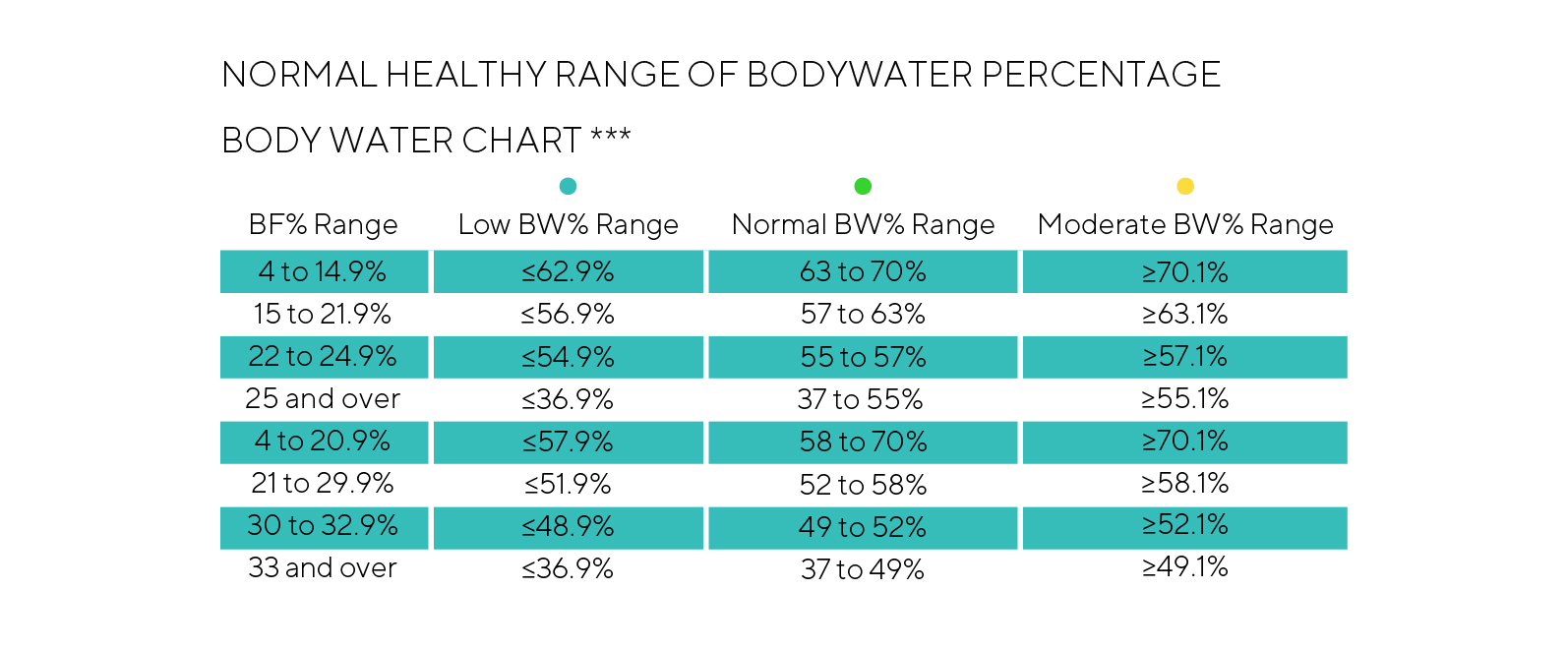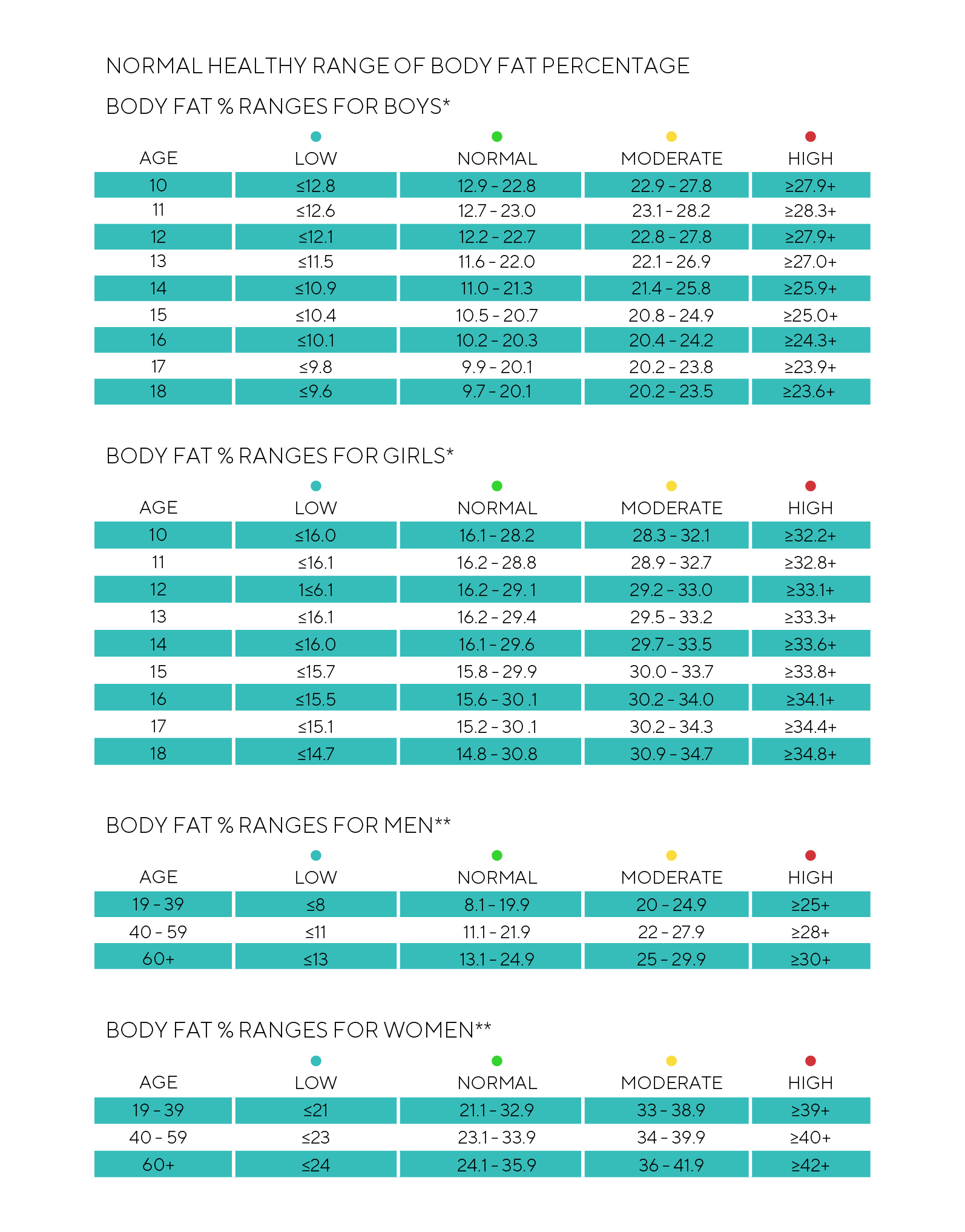Measuring Body Weight & Blood Pressure
Weight
Your body weight is simply your body’s total mass. Body weight naturally fluctuates throughout the day, changing every time you eat, drink, or visit the bathroom. Due to this, it is more meaningful to track your weight over time to see accurate progress. Tracking your weight helps to inform you about your health to make healthy choices.
If you require medical or dietary advice, please consult your doctor or appropriate healthcare professional.
Body Water

***Source: Derived from Wang & Deurenberg: "Hydration of fat-free body mass". American Journal Clin Nulr 1999, 69 833-841.
Body water is the largest element of bodyweight. Water performs a number of important roles in the body; all living cells, whether in the skin, glands, muscles, or brain, can only function properly if they have enough water.
Body Water is estimated using bioelectrical impedance analysis. The results given are for guidance only. If you require medical or dietary advice, please consult your doctor or appropriate healthcare professional.
Body Fat

*Source: Derived from: HD McCarthy, TJ Cole,T Fry, SA Jebb and AM Prentice: "Body fat reference curves for children". International Journal of Obesity (2006) 30, 598-602.
**Source: Derived from: Dympna Gallagher, Steven B Heymsfield, Moonseong Heo, Susan A Jebb, Peter R Murgatroyd, and Voichi Sakamoto: "Healthy percentage body fat ranges: an approach for developing guidelines based on body mass index1-3". Am J Clin Nulr 2000;72:694-701.
The human body is made up of, amongst other things, a percentage of fat. Fat is vital for a healthy, functioning body - it cushions joints and protects vital organs, helps regulate body temperature, stores vitamins and helps the body sustain itself when food is scarce. However, too much or too little body fat can be damaging to your health.
Body Fat is estimated using bioelectrical impedance analysis. The results given are for guidance only. If you require medical or dietary advice, please consult your doctor or appropriate healthcare professional.
Muscle Mass
In most cases, greater muscle mass has positive health effects. As you get older, you naturally lose muscle mass which reduces physical function and increases your risk of injury. If you have high muscle mass, you can slow down muscle loss and protect your physical ability. Muscle mass also increase your overall metabolism. Compared to fat, muscle burns more calories at rest.
Muscle Mass is estimated using bioelectrical impedance analysis. The results given are for guidance only. If you require medical or dietary advice, please consult your doctor or appropriate healthcare professional.
Bone Mass
Regular exercise and a balanced diet can help maintain healthy bones. Like muscle, bone is a living tissue that can become stronger through exercise. For most people, bone mass will peak during their thirties. After that time, we can begin to lose bone mass. Regular exercise coupled with a balanced diet can help maintain healthy bones. Those with osteoporosis or low bone densities may not get accurate estimations.
Bone Mass is estimated using bioelectrical impedance analysis. The results given are for guidance only. If you require medical or dietary advice, please consult your doctor or appropriate healthcare professional.
BMI

Body Mass Index (BMI) uses your weight and height to measure whether you are within a healthy weight range. Your value will put you into one of the BMI categories which are recognised by the World Health Organisation. However, BMI does not distinguish between fat, muscle, or bone mass. Therefore, for certain people such as athletes and others who have a more muscular build it is beneficial to look at this BMI alongside your other metrics such as Body Fat and Muscle Mass.
BMI is calculated using your weight and height. The results given are for guidance only. If you require medical or dietary advice, please consult your doctor or appropriate healthcare professional.
BMR
Your Basal Metabolic Rate (BMR) is an estimation of the energy (measured in calories) expended by the body at rest, to maintain normal bodily functions for 24 hours. This continual work makes up about 60-70% of the total calories the body uses, and includes the beating of your heart, respiration, and the maintenance of body temperature. A number of factors influence your BMR, including age, weight, height, sex and lifestyle. BMR is not the number of calories you should consume to sustain your weight as it only includes the most basic life sustaining functions.
BMR is calculated using your weight, height, age & sex. The results given are for guidance only. If you require medical or dietary advice, please consult your doctor or appropriate healthcare professional.
RFM
RFM stands for Relative Fat Mass and is an estimation of body fat based on height and waist measurements in adults. It is particularly useful for quickly assessing people with both high weight and high muscle mass such as bodybuilders and athletes.
By including waist measurement and sex in the calculation, RFM can more accurately predict the levels of fat mass and non-fat mass in your body therefore potentially reducing the likelihood of misclassification of people as overweight and obese when compared to other formula driven methods of body analysis.
RFM is calculated using your height, waist & sex. The results given are for guidance only. If you require medical or dietary advice, please consult your doctor or appropriate healthcare professional.
LBM
LBM stands for Lean Body Mass, which is comprised of the total weight of your bones, ligaments, tendons, internal organs and muscles. LBM boosts your metabolism so the higher your LBM the more calories your body will burn at rest.
LBM is estimated using bioelectrical impedance analysis. The results given are for guidance only. If you require medical or dietary advice, please consult your doctor or appropriate healthcare professional.
Measurements
Waist Circumference
Track your progress by taking detailed body measurements throughout your journey.
To Measure your Waist:
- Place the measuring tape around your middle, halfway between the bottom of your ribs and top of your hip bone.
- Make sure the tape measure isn’t too tight, it shouldn’t be painful.
- Breathe out naturally and take your measurement.
If you require medical or dietary advice, please consult your doctor or appropriate healthcare professional.
Chest Circumference
Track your progress by taking detailed body measurements throughout your journey.
To Measure your Chest:
- Place the measuring tape around the largest part of your chest, wrapping it round your body under your armpits.
- Make sure the tape measure isn’t too tight, it shouldn’t be painful.
- Breathe out naturally and take your measurement.
If you require medical or dietary advice, please consult your doctor or appropriate healthcare professional.
Hip Circumference
Track your progress by taking detailed body measurements throughout your journey.
To Measure your Hips:
- Place the measuring tape around the largest part of your buttocks making sure that it is level (use a mirror if you are unsure).
- Make sure the tape measure isn’t too tight.
- Take your measurement.
If you require medical or dietary advice, please consult your doctor or appropriate healthcare professional.
Thigh Circumference
Track your progress by taking detailed body measurements throughout your journey.
To Measure your Thigh:
- Stand with your feet shoulder width apart.
- Place the measuring tape around the largest part of your thigh on your non-dominant leg.
- Make sure the tape measure isn’t too tight.
- Take your measurement.
If you require medical or dietary advice, please consult your doctor or appropriate healthcare professional.
Calf Circumference
Track your progress by taking detailed body measurements throughout your journey.
To Measure your Calf:
- Stand with your feet on a level surface approximately 20cm apart
- Place the measuring tape around the largest part of your calf on your non-dominant leg
- Make sure the tape measure isn’t too tight.
- Take your measurement
If you require medical or dietary advice, please consult your doctor or appropriate healthcare professional.
Neck Circumference
Track your progress by taking detailed body measurements throughout your journey.
To Measure your Neck:
- Ensure that your shoulders are relaxed and not hunched
- Place the measuring tape around your neck 2.5cm/1” from where your neck and shoulders meet.
- Make sure the tape measure isn’t too tight.
- Take your measurement.
If you require medical or dietary advice, please consult your doctor or appropriate healthcare professional.
Upper Arm Circumference
Track your progress by taking detailed body measurements throughout your journey.
To Measure your Upper Arm Circumference:
- Locate the mid-point of your non-dominant arm by placing your arm by your side with your elbow flexed at 90° and your palm facing upward.
- Place the measuring tape around your arm, mid-way between your elbow and shoulder.
- Relax your arm so that it hangs freely by your side with your palm facing your thigh.
- Make sure the tape measure isn’t too tight and take your measurement.
If you require medical or dietary advice, please consult your doctor or appropriate healthcare professional.
Height
Using a precise height reading will ensure your body analytics results (such as BMI and RFM) are as accurate as possible.
To Measure your Height:
- Measuring your height is easiest to do with the help of another person.
- Remove your shoes and ensure the floor you’re standing on is flat, even and uncarpeted.
- Stand against a wall with your heels and shoulders touching the wall and look directly forward so your chin is parallel with the floor.
- Have your helper place a flat object (such as a book or a ruler) at a right angle to the wall and resting on the top of your head.
- Lightly mark the wall at the point where the flat object meets your head. If you do not wish to mark the wall, then have your helper hold the object in position.
- Using a tape measure, measure the distance from the floor to the mark on the wall.
If you require medical or dietary advice, please consult your doctor or appropriate healthcare professional.
Heart Health
Blood Pressure

Blood pressure is a measure of the force that your heart uses to pump blood around your body. Monitoring your blood pressure readings can be a useful tool to identify if a person is at risk of heart disease or a stroke.
Understanding your readings: When you take a blood pressure measurement, you’ll receive two numbers.
Systolic blood pressure: This is the top number on your reading. This is the highest level your blood pressure reaches when your heart beats.
Diastolic blood pressure: This is the bottom number on your reading, is the lowest level your blood pressure reaches as your heart relaxes between beats.
If you require medical or dietary advice, please consult your doctor or appropriate healthcare professional.
Heart Rate
Your Heart Rate is the number of times your heart beats per minute (bpm). A normal heart rate is between 60 and 100bpm while you’re resting.
If you require medical or dietary advice, please consult your doctor or appropriate healthcare professional.

